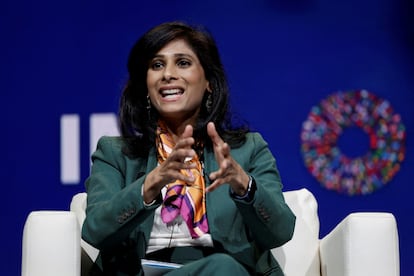Gita Gopinath: ‘We can little afford another Cold War’
When China, the U.S. or the EU imposes a restrictive trade measure on another, there’s a 73% probability that they will respond with a retaliatory measure within 12 months, says the deputy managing director of the International Monetary Fund

The United States, the European Union and China are walking towards a gridlock in terms of trade. The war in Ukraine raised the stakes in an already-tense geopolitical relation between the two biggest economies and their allies, and it could all come down to a new version of the old Cold War, according to Gita Gopinath, deputy managing director of the International Monetary Fund (IMF).
“With the weakest global growth prospects in decades — and with disproportionate scarring from the pandemic and war slowing income convergence between rich and poor nations — we can little afford another Cold War,” Gopinath said to attendees at the World Congress of the International Economic Association on Monday. The event took place in Medellín, Colombia. In conversation with EL PAÍS, Gopinath seemed hopeful about Latin America’s role to play in the energy transition — if trade remains global and open, that is.
In her speech, Gopinath said that “despite efforts by the two biggest economies to cut ties, it is not yet clear how effective they will be in a deeply integrated and connected global economy” as Chinese companies look for alternatives to keep catering to the U.S. market, like moving operations to Vietnam or Mexico.
Question. Are we going through a deglobalization process, or just a rerouting of goods?
Answer. Over the last five years, we’ve seen, firstly, a big increase in trade restrictions that countries are involved in. Last year there were 3,000 new such restrictive trade measures, and 2023 is turning out to be of a similar magnitude. Now, overall global trade-to-GDP (Gross Domestic Product) is relatively stable, so in that sense, there is no deglobalization, at least as of now. But, on the other hand, we are seeing signs of fragmentation. Trade across rival blocs of countries is slowing much more than trade within blocs of countries. And, similarly, if you look at foreign direct investment (FDI) and announced projects, you’re certainly seeing a redirection of projects away from rival countries. As a comparison, during the Cold War of the 1940s to 1980s, we also had a similar episode where there was no deglobalization because you had trade-to-GDP rising quite strongly during that time, but we saw fragmentation. If you look at trade across the U.S. and the former Soviet Union, that fell a lot. So, again, we have a period where I would not say we’re seeing strong or meaningful deglobalization, but we are certainly seeing meaningful fragmentation.
Q. So not deglobalization, but even this meaningful fragmentation you talk about might not be as effective as China and the U.S. intend it to be?
A. Yes. We see fragmentation in the sense of redirection of trade flows and FDI. If you look at the direct links between the U.S. and China, you certainly see quite sizable decline in China’s share in U.S. imports and a significant decline in China as a destination for U.S. development. However, what we are seeing are signs of so-called “connecting countries” like Mexico and Vietnam, countries that might be experiencing trade that ultimately ends up in the U.S. but goes through, potentially, non-aligned countries, and end up in the U.S. This then leads us to the point which is: we are seeing signs of fragmentation, but the extent to which, ultimately, countries can decouple, to effectively not engage in certain sectors, it’s possible that it’s more difficult given the larger economic heft of the non-aligned countries.
Q. Much has been written and analyzed about the Mexico case, as it stands out among its peers for being part of the United States-Mexico-Canada (USMCA) trade deal, but I’m interested in knowing, where does this fragmentation leave Latin America?
A. You’re right that Mexico has an advantage in terms of physical proximity to the U.S. and having the USMCA, which certainly provides benefits for the rest of the region. But several other countries in Latin America have ”green minerals” such as copper, nickel, cobalt, and lithium that play a big role in the energy transition amid this world of fragmentation. We could see Latin America, at least, coming in as an important supplier to the world of green minerals as well as food. It’s yet to be determined how much they can benefit or whether they’re already benefiting from it. It is quite clear that improving the investment environment is going to be critical to be able to attract foreign direct investment, for instance, into these countries. It’s early to say, but this is certainly one avenue through which Latin America can benefit, both green minerals and food exports.
Q. You said in your speech that that countries are now strategically competing with what you called “amorphous rules and without an effective referee.” What is the IMF recommending and who could that referee be?
A. We have the U.S. speaking of “friend-shoring,” the European Union that talks about “de-risking” and China speaks of “self-reliance.” National security is playing a very important role in the driving of decisions on economic policy. The institutions that we have, including the World Trade Organization (WTO), are not really set up to deal with national security-based concerns. It is critically important that every effort is made to strengthen the WTO. The organization’s dispute resolution mechanism is already not functioning. Also, trying to strengthen the WTO to deal with other long-standing issues, including on subsidies, would be how we can make progress.
Q. The IMF outlined several recommendations, like limiting unilateral industrial policy. One example is Chinese subsidies, which could now trigger EU tariffs, but isn’t it also the case that Washington too has incurred in these types of policies?
A. It’s true that we’ve seen quick retaliation when one country places subsidies. When you look at policies imposed by the U.S. and the reactions from the EU and from China, the probability that you will get a retaliatory measure is quite high. When China, the U.S. or the EU imposes a restrictive trade measure on another, there’s a 73% probability that they will respond with a retaliatory measure within 12 months. It’s exactly one of the concerns, that when countries impose such measures, it doesn’t stop there because you get retaliation and counter retaliation. In the U.S., you have well-targeted measures against a clear market failure and externalities, which is true when it comes to dealing with the climate transition. In that case, industrial policies can help if you make it time-bound, as long as you’re not picking one technology over the other. You are better off supporting research and development, which is good for everyone. The difficult part is when local content requirements are added on because that starts conflicting with WTO rules, it starts looking like protectionism.
Q. The environmental cost of global trade is also a concern, especially among activist circles. Can countries really rely on global trade while, at the same time, cutting their carbon emissions?
A. In all our economic activities, being able to do it with fewer carbon emissions is the goal. Trade is a big part of economic activity and transportation plays a very important role. But I would not make it stand separate from the general principle that we have to decarbonize our economic activity more generally. Equally important is that companies invest in renewable energy. For the energy transition to happen, we need access to green minerals. We have seen in our research that the trade restrictions that have been put in place are slowing the green transition. Recent trends in fragmentation are costly and are delaying the transition.
Sign up for our weekly newsletter to get more English-language news coverage from EL PAÍS USA Edition
Tu suscripción se está usando en otro dispositivo
¿Quieres añadir otro usuario a tu suscripción?
Si continúas leyendo en este dispositivo, no se podrá leer en el otro.
FlechaTu suscripción se está usando en otro dispositivo y solo puedes acceder a EL PAÍS desde un dispositivo a la vez.
Si quieres compartir tu cuenta, cambia tu suscripción a la modalidad Premium, así podrás añadir otro usuario. Cada uno accederá con su propia cuenta de email, lo que os permitirá personalizar vuestra experiencia en EL PAÍS.
¿Tienes una suscripción de empresa? Accede aquí para contratar más cuentas.
En el caso de no saber quién está usando tu cuenta, te recomendamos cambiar tu contraseña aquí.
Si decides continuar compartiendo tu cuenta, este mensaje se mostrará en tu dispositivo y en el de la otra persona que está usando tu cuenta de forma indefinida, afectando a tu experiencia de lectura. Puedes consultar aquí los términos y condiciones de la suscripción digital.
More information
Archived In
Últimas noticias
Chris Martin, Taylor Swift, Elijah Wood and other famous wedding ‘crashers’
‘How does it feel to be a failure?’: Elizabeth Berkley’s journey from ‘Showgirls’ ridicule to vindication
The story of the Málaga virus: The code that haunted Google’s cybersecurity center director for 30 years
The impact of Ecuador’s mega-prison: A polluted river, cleared forests and military checkpoints
Most viewed
- Christian Louboutin: ‘Young people don’t want to be like their parents. And if their parents wear sneakers, they’re going to look for something else’
- The low-cost creative revolution: How technology is making art accessible to everyone
- Liset Menéndez de la Prida, neuroscientist: ‘It’s not normal to constantly seek pleasure; it’s important to be bored, to be calm’
- All the effects of gentrification in one corner of Mexico’s Colonia Roma
- December Social Security and SSI payments: Dates, double checks and the 2026 COLA increase










































